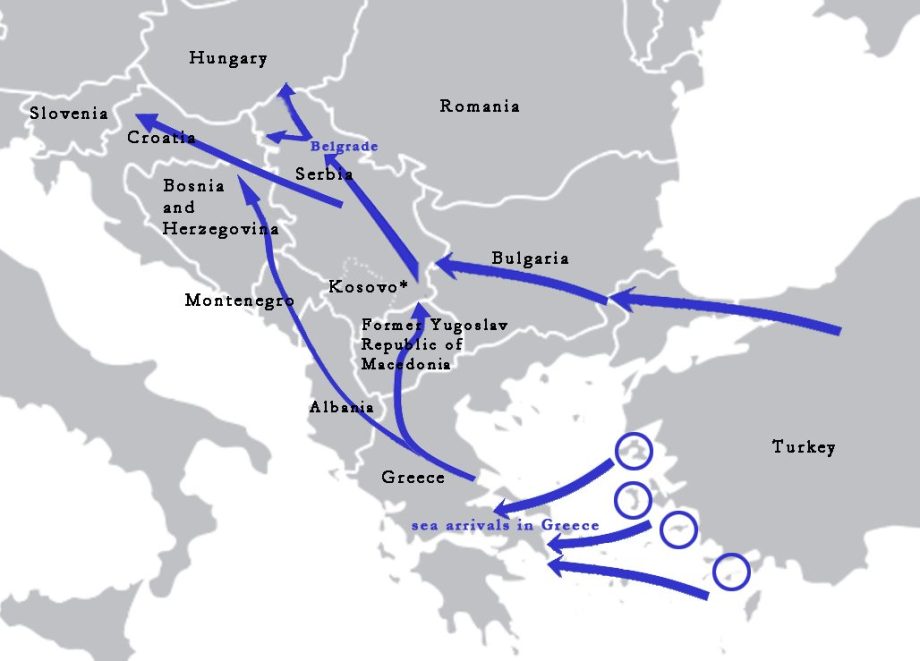The Blame Game Must End: The EU Needs to Shoulder More Responsibility for
The Migrant Crisis in Bosnia and Herzegovina
By Josephine Mintel April 29, 2021
Snow falls over damp sleeping bags and mite-infested mats, which are the only sources of warmth in conditions reaching -15 degrees Celsius for thousands of migrants stranded in Bosnia and Herzegovina[1] near its border with Croatia. This scene typifies this past winter near the city of Bihać, where migrants slept outside for weeks without access to running water, sufficient food, or medical assistance, as respiratory illness and other infectious diseases ran rampant. Local Bosnian authorities and the International Organization for Migration (IOM) were quick to point to border closings due to COVID-19 as the source of the chaos, but this is merely the latest installment of the blame game ongoing since early 2018. After three years, the cycle is now predictable: the concern over the migrants in Bosnia and Herzegovina wanes as the weather warms, but with autumn’s arrival and its portentous hints of the frigid Balkan winter, the European Commission scrambles to allocate short-term funds for suitable refugee facilities while deflecting blame.
 This ongoing crisis obviates how much the European Union wants to keep migrants off its doorstep. Amid the 2015 European migrant crisis, Hungary built near-impenetrable border barriers with its neighboring Balkan nations, Croatia and Serbia. As a result, many migrants followed a new route through the Bosnian forests connecting to EU-member Croatia. According to the Bosnian government, around 60,000 migrants have moved through the country since January 2018, mainly fleeing conflicts from Middle Eastern countries like Syria, Afghanistan, and Pakistan. Currently, approximately 9,000 are living in limbo in Bosnia. These migrants make repeated attempts to cross the border into Croatia, in what they ironically call “the game,” attempting to evade the EU-funded Croatian border police who beat, rob, and sometimes sexually abuse them before pushing them back to Bosnia. Many have been expelled more than 40 times, violating EU protocols for asylum seekers. The Border Violence Monitoring Network and the Danish Refugee Council have documented these allegations, but Croatia denies them. The European Convention on Human Rights prohibits these pushbacks, but so far, the Croatian border police have suffered no consequences.
This ongoing crisis obviates how much the European Union wants to keep migrants off its doorstep. Amid the 2015 European migrant crisis, Hungary built near-impenetrable border barriers with its neighboring Balkan nations, Croatia and Serbia. As a result, many migrants followed a new route through the Bosnian forests connecting to EU-member Croatia. According to the Bosnian government, around 60,000 migrants have moved through the country since January 2018, mainly fleeing conflicts from Middle Eastern countries like Syria, Afghanistan, and Pakistan. Currently, approximately 9,000 are living in limbo in Bosnia. These migrants make repeated attempts to cross the border into Croatia, in what they ironically call “the game,” attempting to evade the EU-funded Croatian border police who beat, rob, and sometimes sexually abuse them before pushing them back to Bosnia. Many have been expelled more than 40 times, violating EU protocols for asylum seekers. The Border Violence Monitoring Network and the Danish Refugee Council have documented these allegations, but Croatia denies them. The European Convention on Human Rights prohibits these pushbacks, but so far, the Croatian border police have suffered no consequences.
Understanding why EU relief efforts have failed to alleviate the crisis requires understanding the dysfunctional postwar government of Bosnia and Herzegovina. The signing of the Dayton Peace Agreement in 1995 ended the Bosnian war, but it also essentially froze the conflict in place using ethnic partitions. Bosnia and Herzegovina is now divided into two entities: the Federation of Bosnia and Herzegovina (FBiH) and the Republika Srpska (RS). The FBiH entity is further divided into ten cantons, and each canton has its own government, which is ethnically categorized based on the three constituent peoples: Serbs, Croats, and Bosniaks (Muslim Bosnians). Both Republika Srpska and the Croatian cantons in FBiH have refused to house migrant facilities, branding it a “Muslim problem.” This political structure has made it impossible to create a nationwide response to the crisis. The EU is painfully aware of the dysfunctional government in Bosnia and Herzegovina, so it is absurd to continue to pressure the “central” government in Sarajevo, expecting to generate a national response.
Migrant camp in Vucjak near Bihac, Bosnia and Herzegovina, on December 6, 2019 [Antonio Bronic/Reuters]
It is time that the EU stop playing the blame game and shoulder more responsibility for the refugee crisis in Bosnia and Herzegovina. Bosnia as Europe’s new migrant center is untenable. The EU should apply additional resources and begin processing asylum claims of the migrants in Bosnia immediately. Those granted asylum should be distributed appropriately among EU countries. The EU must also take legal action against the Croatian border police or withdraw funding if credible allegations of inhumane pushbacks continue. Importantly, greater accountability for EU funds spent by the IOM should be required. The EU cannot exert last-minute pressure on Sarajevo and expect a centralized response from a fragile and fragmented state. As spring arrives, it is time for the EU to take responsibility before the weather changes and a humanitarian crisis looms once more.
[1] hereafter Bosnia for brevity, with no intent to de-emphasize the historical region Herzegovina.
This article was written as a part of my work with the University of Chicago Committee on International Relations.